so tired
Lyme Disease
Nutritional Supplements are Important in the Recovery from Lyme Disease
by Ladd McNamara, M.D.
 The article and protocol are for informational purposes only, and not intended as medical advice. Please see medical disclaimer below, and consult with your personal physician prior to taking supplements and acting upon information in this article, protocol, or website.
The article and protocol are for informational purposes only, and not intended as medical advice. Please see medical disclaimer below, and consult with your personal physician prior to taking supplements and acting upon information in this article, protocol, or website.
Discussion
Tick-borne Lyme disease has become a hidden epidemic, spreading across North America at an alarming rate. The number of new cases in the United States exceeds 300,000 per year! (1) That is 1 ½ times more than breast cancer, and 6 times greater than new cases of HIV/AIDS. (2, 3) From 51 cases diagnosed in 1977, to under 30,000 cases reported in 2010, the rise in the number of new cases to the current >300,000 people per year is staggering.
Lyme disease can affect virtually every tissue and every organ of the body, causing arthritis, fatigue, lethargy, mental fog, and depression, among other signs and symptoms.
Doctors often just look for the classic neurologic manifestations of chronic Lyme disease: cranial neuropathy, peripheral neuropathy, meningitis, or radiculitis. However, in a survey of 3,090 patients suffering with chronic Lyme disease, fatigue, insomnia, and depression were all far more common than the typical neurological signs and symptoms.(4)
In the survey, the 10 symptoms that were reported as severe or very severe were:
- Fatigue (48.3%),
- Sleep Impairment (40.8%),
- Joint Pain (39.1%),
- Muscle Aches (36.1%),
- Other Pain (34.4%),
- Depression (33.8%),
- Cognitive Impairment (32.3%),
- Neuropathy (31.6%),
- Headaches (22.7%)
- Heart-Related Issues (9.6%).
 Sadly, doctors will almost always work up a patient for Lyme disease if they have the typical neurological symptoms, but rarely test for Lyme disease if they have the most common symptoms, that of fatigue, insomnia, and depression. As a result, patients are often misdiagnosed, and treated with antidepressants.
Sadly, doctors will almost always work up a patient for Lyme disease if they have the typical neurological symptoms, but rarely test for Lyme disease if they have the most common symptoms, that of fatigue, insomnia, and depression. As a result, patients are often misdiagnosed, and treated with antidepressants.
If caught early, Lyme disease can be successfully treated with antibiotics. However, about 10 – 15% of infected people develop a chronic debilitating disease despite treatment. Those who go on to develop the chronic disease appear to be largely dependent upon the status of their immune system. This is why my micronutrient supplement protocols play a major role in the management of symptoms, and the progression of Lyme disease.
Stages of Lyme Disease
There are 3 stages of Lyme disease, early localized, early disseminated, and late disseminated (or chronic Lyme disease), each with typical signs and symptoms.
Stage 1: Early, Localized Infection. Developing About 1 Week after Tick Bite (with a range of 3 days – a few weeks):
- Bullseye Rash, “Erythema Migrans.” Occurs in about 70 – 80% of Cases
- Fever & Chills
- Joint Pain
- Muscle Aches
Stage 2: Early Disseminated Disease. Developing 1 – 4 Months After Tick Bite
 Joint Pain & Swelling, Especially in Knees
Joint Pain & Swelling, Especially in Knees- Pain, Weakness, and/or Numbness in Arms and/or Legs
- Unilateral or Bilateral Facial Paralysis (99% resolve)
- Repetitive Headaches
- Fainting Episodes
- Conjunctivitis
- Expanding Initial Circular Rash, or Rashes Elsewhere
- Mental Fog (Memory and Concentration Challenges)
- Occasional Heart Palpitations
The symptoms of 2nd and 3rd stage of Lyme disease mimics many other diseases and can be easily misdiagnosed as juvenile arthritis in the young, and in adults, misdiagnosed as an autoimmune disease (multiple sclerosis, fibromyalgia, etc.), and/or chronic fatigue syndrome, arthritis, depression, or Bell’s Palsy (in the 11% that experience facial paralysis).
Stage 3: Late Disseminated or Chronic Disease. Months – Years after Bite:
- Chronic, Recurrent Swelling and Pain in Joints (Lyme Arthritis)
- Chronic Fatigue
- Trouble with Concentration and Memory
- Depression
- Insomnia
- Inflammation of the Heart (Pericarditis)
- Shooting Pains and Tingling in Arms and/or Legs
The 3rd stage signs and symptoms may be the first noticeable signs and symptoms of Lyme disease.
My Professional Experience
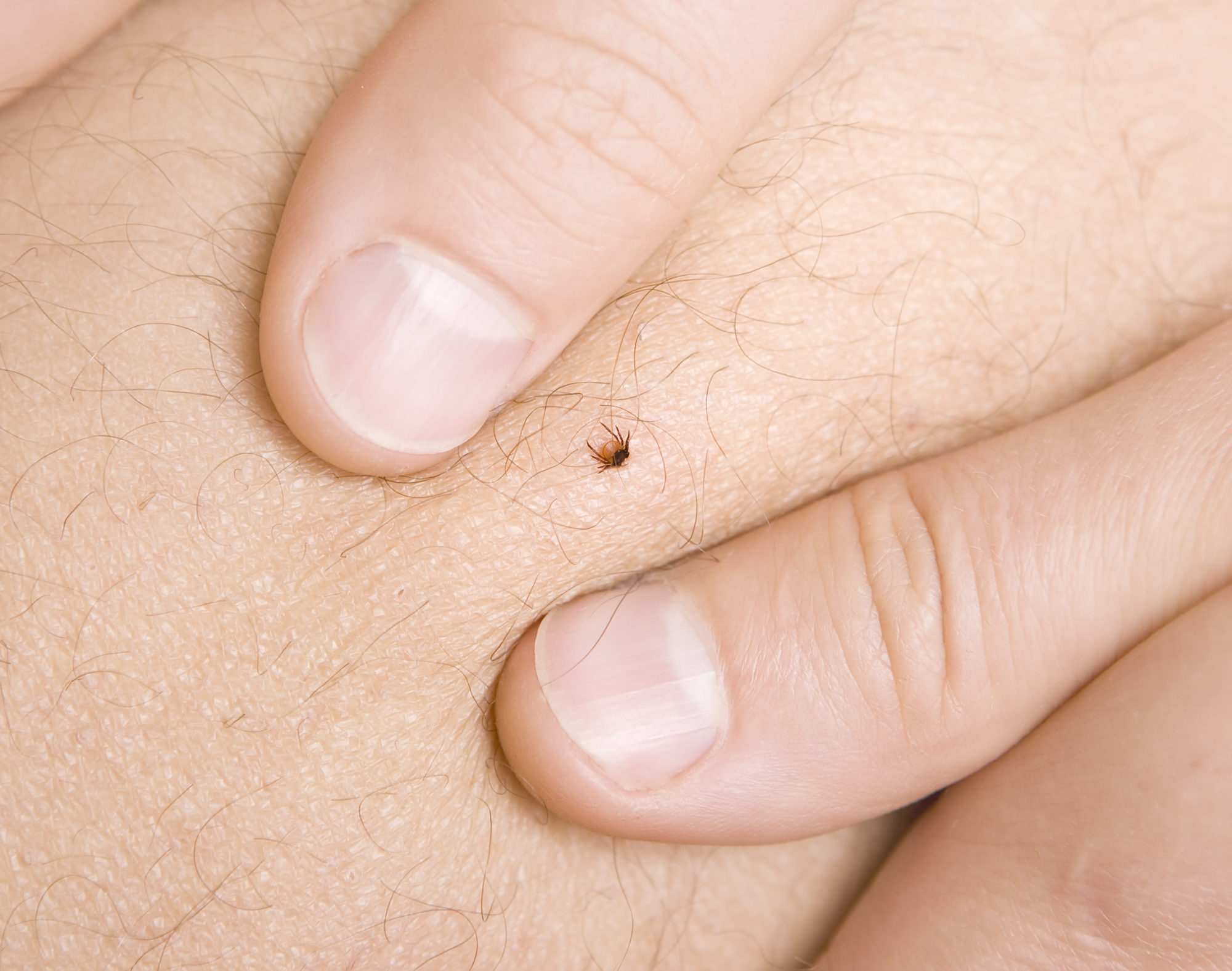 My first personal experience with Lyme disease was in my very first week of practice of gynecology in 1993 in Atlanta, Georgia. Lyme disease was not on most doctors’ radar, and it was thought to be only relegated to the Northeastern United States.
My first personal experience with Lyme disease was in my very first week of practice of gynecology in 1993 in Atlanta, Georgia. Lyme disease was not on most doctors’ radar, and it was thought to be only relegated to the Northeastern United States.
During the annual GYN exam, I inquired about her health. She told me that she had been working with specialists in a few states over the prior 2 years, running tens of thousands of dollars of tests to try and figure out what was wrong with her, and she was beginning to think she was “crazy.”
In her late 30’s, she knew something was wrong with her, as she experienced debilitating fatigue, depression, brain fog, intermittent heart palpitations, and arthritic flare ups. The tests for autoimmune diseases, heart problems, infections, CT scans, blood work, etc. were all negative.
I listened for about 5 – 10 minutes, and a thought simply flashed in my mind. I said, “Sounds like it could be Lyme disease.” She looked at me like I had told her she was incubating an alien or something, and told me there was no history of a tick bite, and that she never went hiking or camping and certainly never had a “bulls eye” rash.
I told her that I was going to get a blood test for Lyme disease anyway, as it couldn’t hurt. To her surprise, and that of her many specialists, she tested positive for Lyme disease and was successfully treated with antibiotics. Within a few weeks, she had her life back. I was glad to be in the right place at the right time to have facilitated the breakthrough.
This experience illustrates how patients can experience strange, progressing symptoms that rob them of life’s energy, causing frustration and affecting relationships, work, and happiness.
Today the awareness of Lyme disease is much greater, and many physicians often correctly diagnose and treat it. However, some patients are not diagnosed until well into stage 3, and continue to have debilitating symptoms despite treatment.
The Rise of Lyme Disease
 As of the mid-1990’s, Lyme disease went on to become the largest tick-borne disease in North America.(5) Though the Northeast and upper Midwest remain endemic (and quickly becoming epidemic) for Lyme disease, with expansion into the Southeastern states and the West Coast, the disease has spread from coast-to-coast, into Canada and Mexico. Every state in the Union except Hawaii have reported cases of Lyme disease.
As of the mid-1990’s, Lyme disease went on to become the largest tick-borne disease in North America.(5) Though the Northeast and upper Midwest remain endemic (and quickly becoming epidemic) for Lyme disease, with expansion into the Southeastern states and the West Coast, the disease has spread from coast-to-coast, into Canada and Mexico. Every state in the Union except Hawaii have reported cases of Lyme disease.
Prior to Lyme disease being known, in 1975, a cluster of children in Old Lyme, Connecticut, were diagnosed with juvenile arthritis. Parents pushed for answers, as they recognized that the growing number of people developing similar symptoms could not be coincidence. They wanted answers.
In 1977, 51 cases in and around Lyme, Connecticut, were linked to the black-legged deer tick. Obviously, the syndrome was aptly named for the modern-day birth place of this new disease; but, the pathogen causing the disease was yet to be identified.
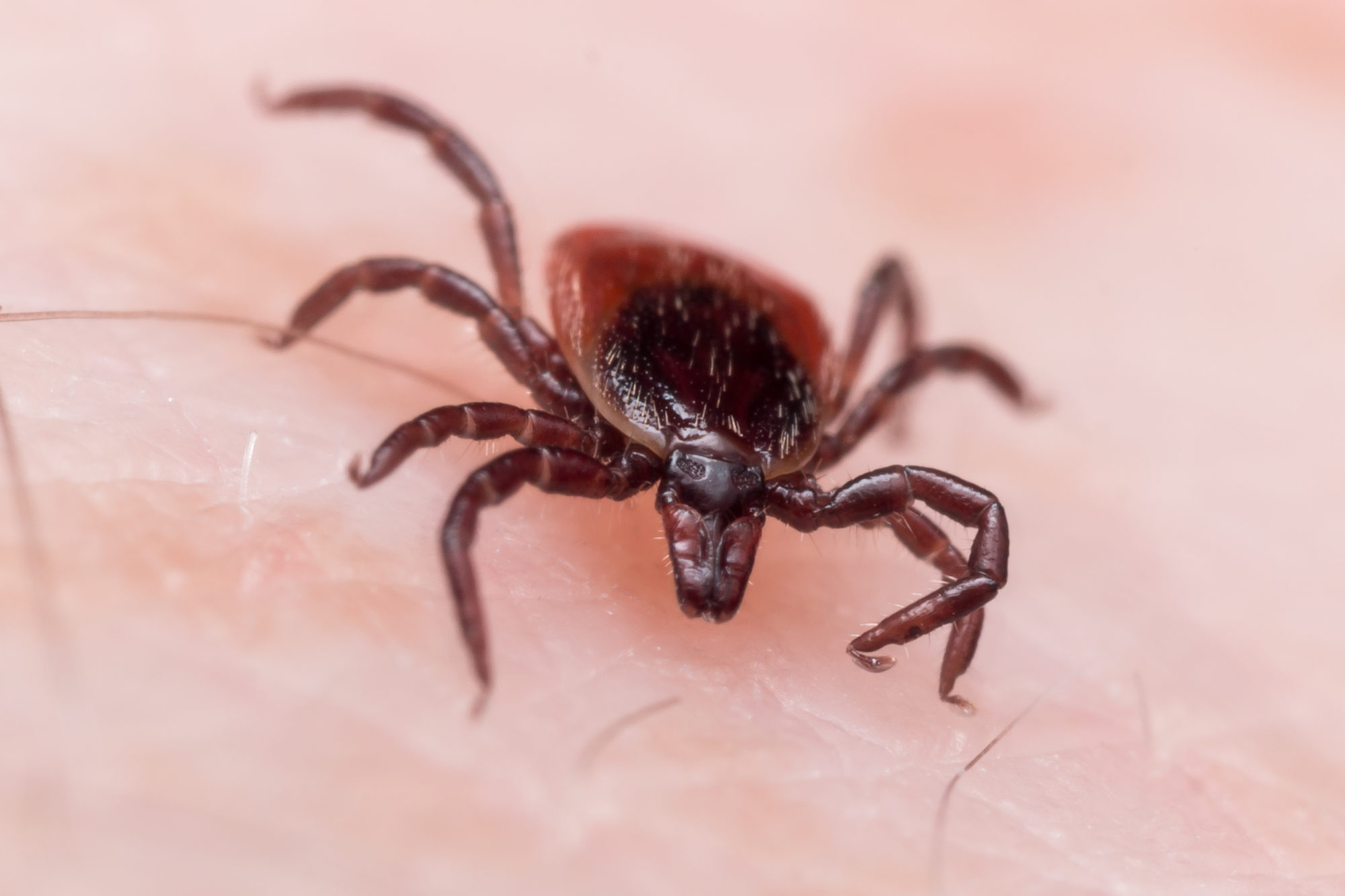 In 1981, Dr. Willy Burgdorfer isolated and identified the bacterium responsible for Lyme disease from a deer tick. It was a newly-discovered spiral, or corkscrew-shaped bacterium, a spirochete of the Borreli genus.
In 1981, Dr. Willy Burgdorfer isolated and identified the bacterium responsible for Lyme disease from a deer tick. It was a newly-discovered spiral, or corkscrew-shaped bacterium, a spirochete of the Borreli genus.
Spirochetes are particularly difficult to diagnose and treat due to the nature of these bacteria, and this newly-discovered bacterium turned out to be exceptionally unique in its ability to infect and disseminate in the body. This spirochete bacterium was named after Dr. Burgdorfer, Borreli burgdorferi. Dr. Burgdorfer also suspected that the Rickettsia bacterium, carried by ticks may also be involved in Lyme disease.
In 1999, it was discovered that a person with Lyme disease could be infected with several different strains of Borreli burgdorferi. Collectively, these strains are known as Borrelia burgdorferi sensu stricto. (6)
In June of 2016, Borreli mavonii was identified to be causing many cases of Lyme disease, particularly in the upper Midwest. (7) It is obvious that the bacterium is diverse, develops multiple strains, and can change characteristics within the body, complicating diagnosis and treatment.
The Lyme Disease Bacterium
 Lyme disease is caused by several strains of the spirochete Borrelia bacterium, the same type of bacteria as Treponema pallidum, the bacterium that causes syphilis. In the United States, the two most common strains are, Borrelia burgdorferi and Borrelia mavonii; the latter being found mostly in the upper Midwest. In Europe and Asia, the strains are most commonly Borrelia afzelli and Borrelia garini. (8)
Lyme disease is caused by several strains of the spirochete Borrelia bacterium, the same type of bacteria as Treponema pallidum, the bacterium that causes syphilis. In the United States, the two most common strains are, Borrelia burgdorferi and Borrelia mavonii; the latter being found mostly in the upper Midwest. In Europe and Asia, the strains are most commonly Borrelia afzelli and Borrelia garini. (8)
Complicating Lyme disease, many patients may be infected with more than one strain of Borrelia burgdorferi, as well as co-infected with an entirely different type of bacteria. (9)
In addition, the ability of Borrelia burgdorferi to evade the immune system, and actually “hide” dormant inside cells for years, and change the expression of cell surface proteins (antigens) as they are being attacked by cells of the immune system, makes it very difficult to clear from the body, especially when it gets into the brain.
Contracting Lyme Disease
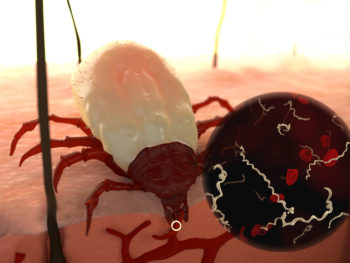 Ticks feed on humans, small mammals, and birds, and in the West, lizards. Borreli bacteria are not transmitted unless ticks feed for about 36 – 48 hours.(10) Most humans will notice adult ticks and remove them before the bacteria can be transmitted successfully from the tick’s salivary glands. However, ticks in the nymph state, which are very small, about the size of the head of a pin, can go unnoticed; and account for most cases of Lyme disease transmission to humans.
Ticks feed on humans, small mammals, and birds, and in the West, lizards. Borreli bacteria are not transmitted unless ticks feed for about 36 – 48 hours.(10) Most humans will notice adult ticks and remove them before the bacteria can be transmitted successfully from the tick’s salivary glands. However, ticks in the nymph state, which are very small, about the size of the head of a pin, can go unnoticed; and account for most cases of Lyme disease transmission to humans.
The Borreli bacterium is not transmitted from human-to-human through casual contact, nor is it known, or thought to be transmitted through sexual contact. Nor is it transmitted through food, water, air, or mosquito bites. Although no case has been reported of acquisition via blood transfusion, it is possible that an infected person donates blood, and that infected blood is given to a recipient; which could lead directly to the 2nd stage of Lyme disease. Therefore, a person with active Lyme disease should not donate blood.
The Borreli bacterium is known to infect and make carriers of humans, small mammals, dogs, cats, rodents, birds, and in the West, lizards. (11) The bacteria are carried by the ticks, which are the vectors for the disease. Uninfected ticks pick up the bacteria from infected animals that they feed on, and deliver them to other animals while feeding. The newly-infected animal becomes a reservoir, or carrier, of the bacteria. The ticks also feed on and are carried by deer, but the deer are totally immune to the Borrelia bacteria.
Survival Mechanisms of Borreli Bacterium
The key to successful treatment and management of Lyme disease lies in the understanding of the bacterium’s survival mechanisms: replication, the ability to spread to other organisms, to evade the immune system, and disseminate in the body and infect nearly all cell types. In addition to antibiotics, a variety of nutritional supplements are critical for strengthening the immune system to better target the bacterium, reduce inflammation, support functioning of the brain for normal neuro-transmission, elevate mood, increase energy, and support the heart and muscles, as well as all other tissues, so that all the symptoms are minimized, if not eliminated.
Borrelia burgdorferi is a highly motile bacterium. It can swim extremely efficiently through both blood and tissues, wiggling itself both in-between and through cells because of its internal propulsion and corkscrew shape. The motility of this bacterium allows it to swim towards a tick feeding on an infected animal, so that it can be sucked up into the tick. After entering the tick’s salivary glands, it is able to be injected into another animal upon the next feeding, thereby spreading the infection.
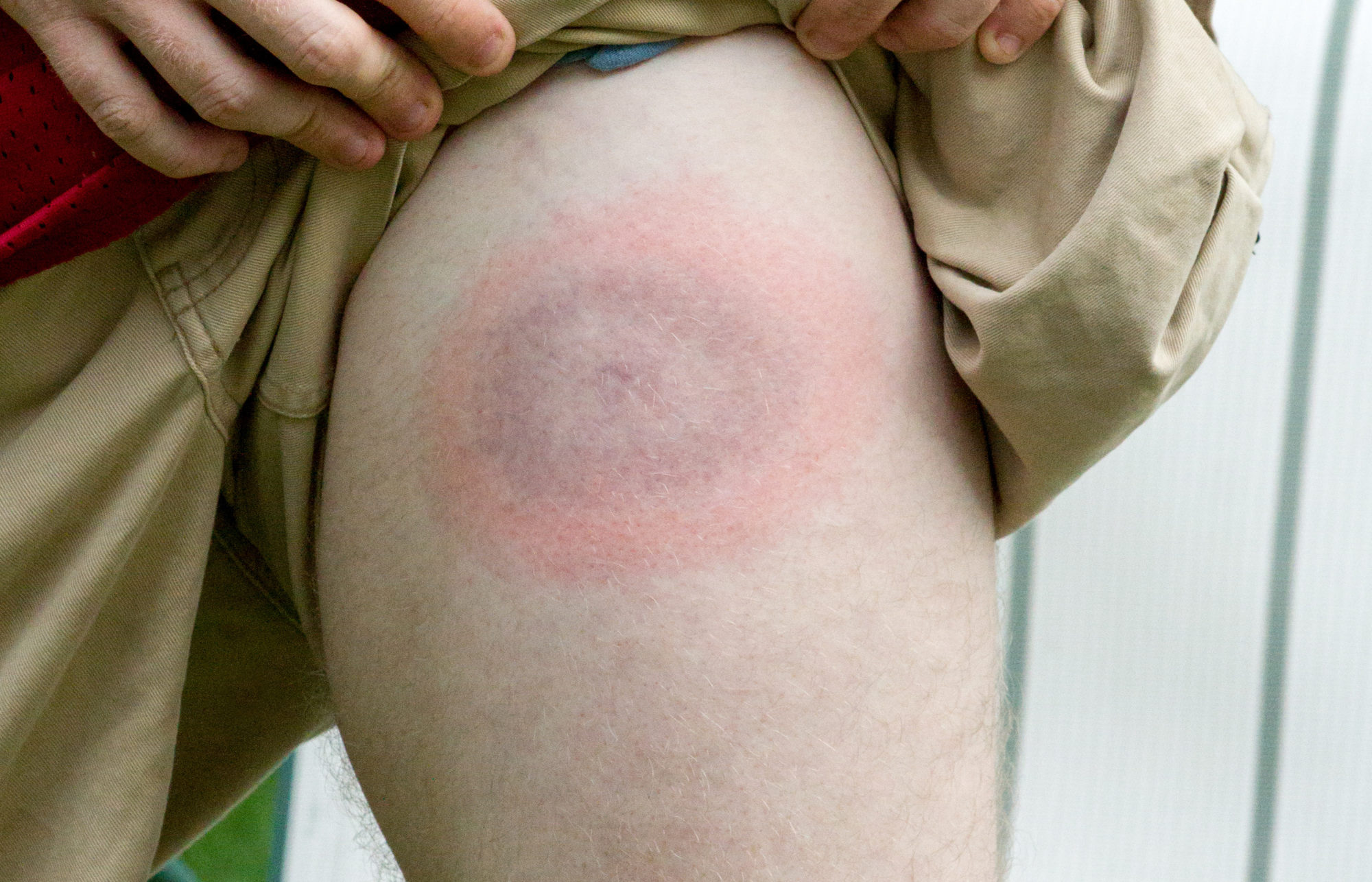 After being injected into another animal, this unique bacteria send out signals to down-regulate the immune system’s innate ability to defend the body from invasion, and at the same time activate the body’s enzymes to allow for the collection of blood in the layers of the skin, giving the bacteria a rich supply of blood in which it multiplies. This accounts for the characteristic bullseye rash seen in stage 1, known as erythema migrans (literally ‘moving redness’).
After being injected into another animal, this unique bacteria send out signals to down-regulate the immune system’s innate ability to defend the body from invasion, and at the same time activate the body’s enzymes to allow for the collection of blood in the layers of the skin, giving the bacteria a rich supply of blood in which it multiplies. This accounts for the characteristic bullseye rash seen in stage 1, known as erythema migrans (literally ‘moving redness’).
The bacteria are able to escape much of the capture by the immune system’s macrophages coming to engulf them, simply by wiggling away faster than the macrophages can catch them. And if a macrophage captures a bacterium, it is resistant to hydrogen peroxide used by macrophages to disrupt bacteria. Despite being evaded, the immune system is able to produce antibodies against the bacteria after a few weeks, which allows the macrophage to better kill the bacteria with nitric oxide and other chemicals.
Despite the antibodies forming against the bacteria, Borrelia are able to change their surface antigens to become ‘invisible.’ to the antibodies. It is a cat and mouse game, with the mouse often winning.
Increase in Oxidative Stress and Inflammation
Borrelia burgdorferi infections cause an increase in oxidative damage within the mitochondria of macrophage cells. (12) This is usually seen in old, worn out mitochondria. In effect, the bacteria are aging the mitochondria that produce energy for the cell to function.
The endogenous antioxidant enzymes, catalase, super oxide dismutase, and glutathione peroxidase, among others, are required both within the cell’s cytoplasm AND inside the mitochondria itself. Since Lyme disease is associated with increased oxidative damage within mitochondria, the endogenous antioxidant enzymes are dysfunctional or depleted. This is why in my protocol I have vitamin-antioxidant supplements with a special complex that helps renew both endogenous antioxidant enzymes and healthy mitochondria. This supplement technology becomes very important while treating and managing Lyme disease.
With Borrelia burgdorferi infection, the immune system’s defenses are activated, and inflammatory cytokines and the various white blood cells are recruited. However as mentioned, the bacterium is able to wiggle away from macrophages and down-regulate the activities of other white blood cells, including neutrophils, natural killer cells, and dendritic cells that normally actively defend against bacterial invasion.
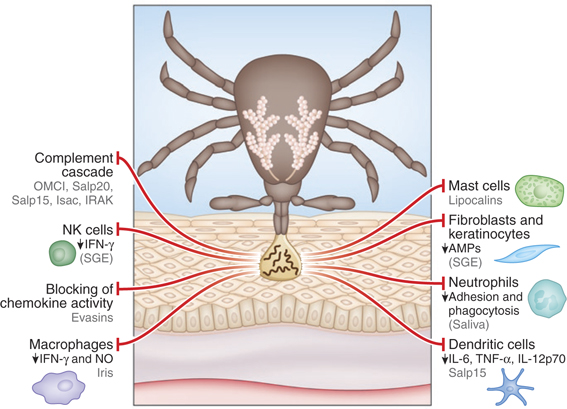
Other unique features of Borrelia burgdorferi are its stealth abilities. It has a glycol, gel-type coating of ‘slime,’ virtually cloaking it from the immunes system. Since the immune system needs to recognize foreign proteins to mount an acquired immune response to invaders, Borrelia burgdorferi expresses very few outer surface proteins (antigens), further allowing it to enter, and move through the body in a stealth fashion.
The immune system normally uses a bacteria’s (or virus’) unique surface proteins (antigens) to allow B-lymphocytes to create unique antibodies against the species, to allow for destruction by macrophages and activated T-lymphocytes. Our immune system is a complex and beautiful system that protects us from infections. However, it is also vulnerable to stress and lack of nutrients that cause it to operate less than optimally. With Borrelia burgdorferi’s unique abilities, it can easily evade a less than optimal immune defense.
In addition, when under attack, Borrelia burgdorferi can quickly change the few expressed surface proteins (antigens), to further hide from the immune system. And if antibodies are made against the specific strain, the antigens on the surface of the bacterium are also altered, rendering them “invisible” to the newly-created antibodies.
Borrelia burgdorferi is also capable of blocking antibodies against it by burrowing into B-lymphocytes, which are the white blood cells that produce antibodies. The bacterium burrows into B-lymphocytes, disrupting the cell membrane, and then “wearing” part of the cell membrane as a coat to cloak itself. The cell membrane “coat” has the person’s proteins, recognized by the immune system as “self,” and the immune system does not mount an immune response to self — not normally anyway.
Triggering an Autoimmune Response
In some cases, Lyme disease triggers an autoimmune response. It may be possible that the bacterium wearing the B-lymphocyte membrane as a coat may trigger the immune system to cause other B-lymphocytes to create antibodies against the combination of the bacterium’s few surface antigens mixed with the person’s own antigens. (13) The antibodies would now attack the person’s cells that express those “self” proteins. This can turn into an autoimmune disorder.
People with Lyme disease have been found to have auto-antibodies against their own tissue, including nerve cells (axons), cardiolipid, myelin and myelin basic protein (as seen in multiple sclerosis), and neurons (brain cells). (14) Lyme disease patients may develop autoimmune polyarthritis: rheumatoid arthritis, psoriatic arthritis, or peripheral spondyloarthritis. (15)
This aspect of some Lyme patients developing auto-antibodies can be alleviated with nutritional supplements, particularly grape seed extract and curcumin (as I have written about in an article, on Autoimmune Disease, as well as in the article on Multiple Sclerosis). The same principles should apply to managing the effects of autoimmune antibodies developed in Lyme disease.
Testing for Lyme Disease to Make the Diagnosis
 The ELISA test is sensitive, but non-specific. It can cross-react in cases of an autoimmune disease, such as rheumatoid arthritis, Lupus, etc. However it is still worth doing, as it gives a strong indication of the disease.
The ELISA test is sensitive, but non-specific. It can cross-react in cases of an autoimmune disease, such as rheumatoid arthritis, Lupus, etc. However it is still worth doing, as it gives a strong indication of the disease.
The Western Blot is specific and accurate for Lyme disease, as it tests specifically for the main bacterium that causes Lyme disease, B. burgdorferi. However the Western blot is only specific to ONE STRAIN of bacterium that causes Lyme, B. burgdorferi B31. There are many strains that cause Lyme, so it may be negative, but it is possible to still have Lyme disease.
It is possible to test positive in the ELISA test, yet have a negative Western blot test, because a different strain (other than the B. burgdorferi B31 ) could very well be causing the Lyme disease. This is becoming more common. There are different strains that are more prevalent in different geographical regions than others.
 Therefore I highly recommend getting tested with the “Igenex” test. The Igenex test still does not test for all strains of the Borrelia bacterium, but at least it tests for more than one; it tests for 8 strains of bacteria that are known to cause the infection. It is possible to be infected with one of the strains that are not being analyzed by the Igenex test, and therefore the Western blot and the Igenex test would all be negative despite truly having Lyme disease. This is why the CDC recommends diagnosis and treatment based upon clinical presentation, and not relying solely on lab tests to make the diagnosis of Lyme disease.
Therefore I highly recommend getting tested with the “Igenex” test. The Igenex test still does not test for all strains of the Borrelia bacterium, but at least it tests for more than one; it tests for 8 strains of bacteria that are known to cause the infection. It is possible to be infected with one of the strains that are not being analyzed by the Igenex test, and therefore the Western blot and the Igenex test would all be negative despite truly having Lyme disease. This is why the CDC recommends diagnosis and treatment based upon clinical presentation, and not relying solely on lab tests to make the diagnosis of Lyme disease.
Keeping Your Immune System Strong is Key for Lyme Disease Prevention & Management
A person with an unhealthy, or less-than primed immune system is particularly vulnerable to infection by the Lyme disease bacterium. Vitamins, minerals, antioxidants, omega-3 fatty acids, and beta glucans are needed to strengthen the immune system and inhibit the bacterium, as well as to manage the consequences of the bacterium on tissues throughout the body.
 Studies have shown that those with lower blood concentrations of vitamins A, C, and E, are prone to develop Lyme disease. (16) Vitamin A deficiency is associated with worsened arthritis in Lyme disease. (17) Zinc has been shown to inhibit enzymes in the metabolic processes of Borrelia burgdorferi. (18)
Studies have shown that those with lower blood concentrations of vitamins A, C, and E, are prone to develop Lyme disease. (16) Vitamin A deficiency is associated with worsened arthritis in Lyme disease. (17) Zinc has been shown to inhibit enzymes in the metabolic processes of Borrelia burgdorferi. (18)
Magnesium deficiency, like vitamin D deficiency, is an epidemic, and is associated with poor neurological and muscular symptoms, including anxiety, twitching, and spasms. (19) Co-enzyme Q10 helps support the function of the brain and muscles, and together with magnesium and alpha lipoic acid, is used in the mitochondria to convert glucose and oxygen into the cell’s energy currency, ATP. An abundance of micronutrients is necessary for optimal function of all cells, and even more so for the high energy-requiring cells of the mitochondria, which are abundant in muscles, heart, and nerves. Lyme disease increases the requirement for these micronutrients.
Beta Glucan Polysaccharides
 The unique capabilities of Borrelia burgdorferi challenges a normal immune system, and can readily infiltrate and proliferate in a person with a suppressed immune system. For this reason, I suggest that everyone keep their immune system at peak performance with a variety of vitamins, minerals, antioxidants, and beta glucan supplements. Beta glucans are particularly useful for immunomodulation, boosting the immune system when under attack by foreign bacteria and cancer, and not causing an over-reaction, as in the case of allergies and autoimmune disorders.
The unique capabilities of Borrelia burgdorferi challenges a normal immune system, and can readily infiltrate and proliferate in a person with a suppressed immune system. For this reason, I suggest that everyone keep their immune system at peak performance with a variety of vitamins, minerals, antioxidants, and beta glucan supplements. Beta glucans are particularly useful for immunomodulation, boosting the immune system when under attack by foreign bacteria and cancer, and not causing an over-reaction, as in the case of allergies and autoimmune disorders.
Beta glucans, a polysaccharide fiber derived from the cell membranes of the Shiitake and Reishi mushrooms, as well as baker’s yeast extract, are particularly useful in fighting the bacterium that causes Lyme disease, by giving an advantage to the immune system. Beta glucans activate multiple white blood cells, improving the innate and acquired capabilities of the immune system to be able to defend against and help keep in check the tenacious Borrelia bacteria.
White blood cells, particularly macrophages and natural killer cells, have beta glucan receptors. Beta glucans trigger, or activate macrophages to aggressively go after bacteria (and cancer cells). They release cytokines to activate T-lymphocytes to more actively go after bacteria and cancer cells that have been coated with complement proteins. Beta glucans trigger the natural killer cells to go after bacteria and cancer cells aggressively.
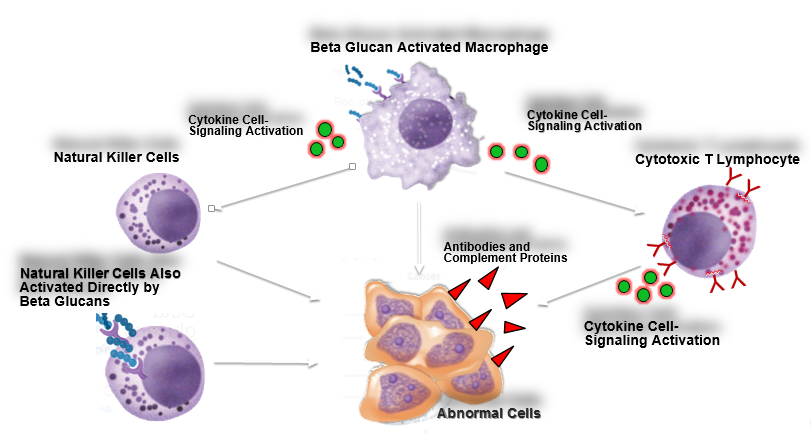
Research has shown that beta glucans assist macrophages in engulfing Lyme bacteria more readily, which is why beta glucans are a critical component in my Lyme disease protocol. (20)
Beta glucans, along with other antioxidants such as grape seed extract and curcumin, as well as vitamin D, give the immune system a fighting chance against the bacteria. The immune system cannot win without antibiotics, which is why both antibiotics and supplementation need to be employed in the treatment and management of Lyme disease.
Most other bacteria, e.g., strep and staph, double in number every 20 minutes. Antibiotics usually only work when the cells are dividing. Not all bacteria divide at the same time, so antibiotics have to be taken several times per day, keeping blood concentrations of antibiotics steady for about 10 days to get adequate killing and depleting the population of bacteria.
In contrast to a 20-minute doubling time, Borreli burgdorferi double in number every 12 – 24 hours. This means that to get the same killing effect on Borreli bacteria as 10 days of antibiotics for strep or staph infections, a person would need to take antibiotics steadily, every day for 18 months!
However, although antibiotics are needed to kill an active infection, treating chronic Lyme disease with long-term antibiotics is not only ineffective, it can be harmful. (21) Antibiotics wreak havoc on gut bacteria, which is critical for immune health, as well as digestive health and mood. Gut bacteria also play an important role in maintaining mood. (22) The health of the gut is connected to the health of the brain, skin, and immune system. (23)
Probiotics
 Probiotics are necessary every day in those with Lyme disease, and especially while on antibiotics. The probiotics that I recommend in my protocol provide 2 strains of probiotics that are resistant to stomach acid and warm temperatures. Supplementing with these two strains helps maintain a healthy intestinal microbiome. A healthy bowel microbiome also helps with mood!
Probiotics are necessary every day in those with Lyme disease, and especially while on antibiotics. The probiotics that I recommend in my protocol provide 2 strains of probiotics that are resistant to stomach acid and warm temperatures. Supplementing with these two strains helps maintain a healthy intestinal microbiome. A healthy bowel microbiome also helps with mood!
Treating with antibiotics as soon as possible after the tick bite may help prevent the bacteria from dissemination through the bloodstream to other organs. Probiotics should be administered daily, especially during antibiotic treatment.
Invasive Nature of Borreli
Borreli burgdorferi are also unique in that they do not produce their own enzymes to break down cell membranes for invasion. They are able to enter and exit the bloodstream by burrowing into the cells that line the blood vessels, by corkscrewing through the cell membrane and inducing that cell to undergo apoptosis, or self-destruction. With the cells that line the blood vessel destroyed, the bacterium tunnels in and out of blood vessels, and into organ tissues, as well as in-between cells.
 The bacteria disseminate into any and every tissue; the joints, skin, muscles, heart, liver, spleen, kidneys, brain, eyes, intestine, bladder, etc. There they continue to evade the immune system and multiply; or they go dormant before replicating again and causing symptoms.
The bacteria disseminate into any and every tissue; the joints, skin, muscles, heart, liver, spleen, kidneys, brain, eyes, intestine, bladder, etc. There they continue to evade the immune system and multiply; or they go dormant before replicating again and causing symptoms.
Borreli burgdorferi, like other spirochetes, such as those that cause syphilis, can remain hiding in the human body, remaining essentially in suspended animation for years. If the bacterium are not metabolizing and dividing, antibiotics are useless. If the immune system is stressed or suppressed, the bacterium are able to begin replicating and seed back into the bloodstream and initiating a relapse of disease and symptoms.
Unlike viral infections that impart an acquired immunity with antibodies, your immune system does not retain an immunity to bacteria. This is why a person can get strep or staph infections many times. The same goes for Lyme disease. A person with Lyme disease who is successfully treated can later become infected with the same, or many other strains of the Borrelia bacteria. (24)
Remaining on a high quality, broad spectrum, bio-available nutritional supplement is important to keep the immune system primed at peak performance to both manage Lyme disease, and to help prevent repeat infections, including those of other strains. Of course, guarding against additional tick bites is obvious.
Grape Seed Extract, Turmeric Extract, and Other Micronutrients
 High doses of grape seed extract, turmeric extract (curcumin), vitamin D, and omega-3 fatty acids, along with DHEA, 5-HTP, NAC, GABA are needed to maintain the health of the brain’s neuron connections and myelin sheath.
High doses of grape seed extract, turmeric extract (curcumin), vitamin D, and omega-3 fatty acids, along with DHEA, 5-HTP, NAC, GABA are needed to maintain the health of the brain’s neuron connections and myelin sheath.
About 10% of Lyme disease cases involve the brain. (25) When the central nervous system becomes inflamed, macrophages release a neurotoxin, called quinolinic acid. This chemical causes neurons to repeatedly depolarize, preventing proper conduction of the nerve signals; leading to demyelination. This causes deficits in memory and thinking, along with possible paralysis. The release of quinolinic acid is also seen in Parkinson’s disease, multiple sclerosis, ALS, and AIDS.
Involvement of the Brain
Research has found that in patients with Lyme encephalopathy, inflammatory cytokines in the brain affect metabolism and regulation of the amino acid tryptophan.(26) Rather than converting into 5-HTP, and then to serotonin, the mood-enhancing hormone, tryptophan is converted into quinolinic acid, which is neurotoxic. This accounts for the encephalopathy; including memory deficits, interference of cognition, and insomnia.
The amino acid derivative, 5-HTP can be administered to help with mood, and is the preferred supplement in this situation particularly, as it is the immediate precursor to serotonin synthesis. 5-HTP is not converted into quinolinic acid, and along with melatonin, can help restore normal sleep-wake cycles.
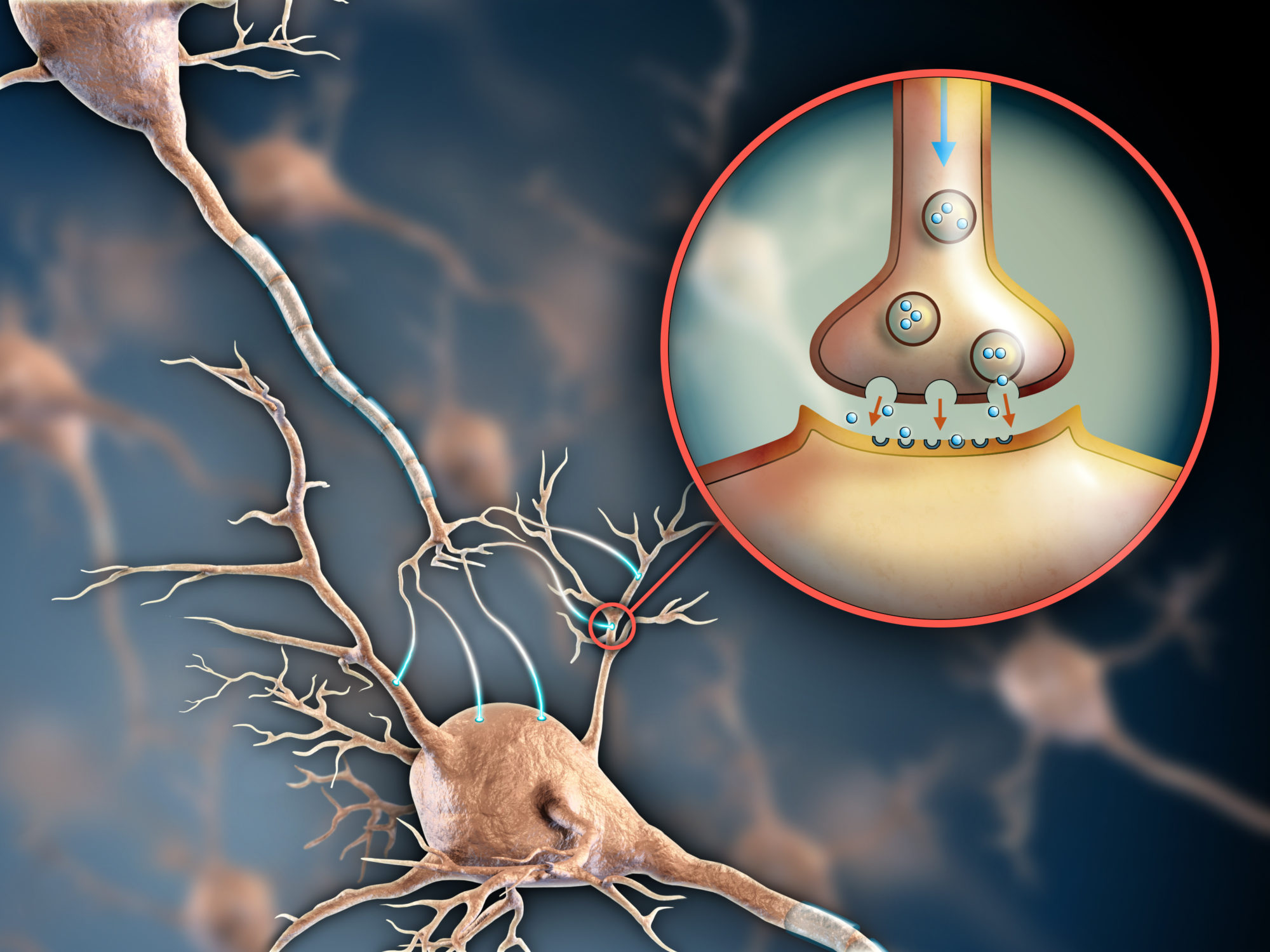 Inflammation reduces the production of serotonin. Therefore, reducing inflammation with antioxidants, including NAC, grape seed extract, turmeric extract, and beta glucans, along with supplementing with 5-HTP, GABA, L-theanine, and melatonin, helps restore serotonin levels, thus reducing anxiety, elevating mood, and improving sleep.
Inflammation reduces the production of serotonin. Therefore, reducing inflammation with antioxidants, including NAC, grape seed extract, turmeric extract, and beta glucans, along with supplementing with 5-HTP, GABA, L-theanine, and melatonin, helps restore serotonin levels, thus reducing anxiety, elevating mood, and improving sleep.
In the neuronal synapses of the brain, glutamate, or glutamic acid stimulates the subsequent neuron, acting upon the receptors for only 1 millisecond, before it is taken away. Abnormally-high glutamate concentrations in the synapses is seen in ALS, Huntington’s chorea, epilepsy, Alzheimer’s disease, schizophrenia, and anxiety disorders. When glutamate re-uptake is inhibited, glutamate acts as a neurotoxin, inhibiting neurotransmission. (27)
In Lyme disease, inflammation in the brain by the activation of T-lymphocytes and dendritic cells, causes a rise in glutamate concentrations, and inhibition of neurotransmission. (28) Reducing elevated glutamate concentrations with N-acetyl-L-cysteine (NAC) can provide symptomatic relief and support normal neurological function, i.e., thinking, memory, and sleep.
NAC is a precursor to the powerful antioxidant glutathione (GSH), which inhibits expression of pro-inflammatory cytokines and suppresses nuclear factor-kappa B (NF-kB), reducing inflammation. (29 – 31) NAC supplementation helps reduce toxic glutamate levels in the synapses, and directly and indirectly protects all the cells and organs of the body.
N-acetyl-L-cysteine (NAC), up to 3 grams per day, has shown to be effective in other neurological disorders, including addictions (marijuana, nicotine, cocaine, gambling), OCD, bipolar disorder, schizophrenia, and trichotillomania (hair pulling). (32)
Conclusion
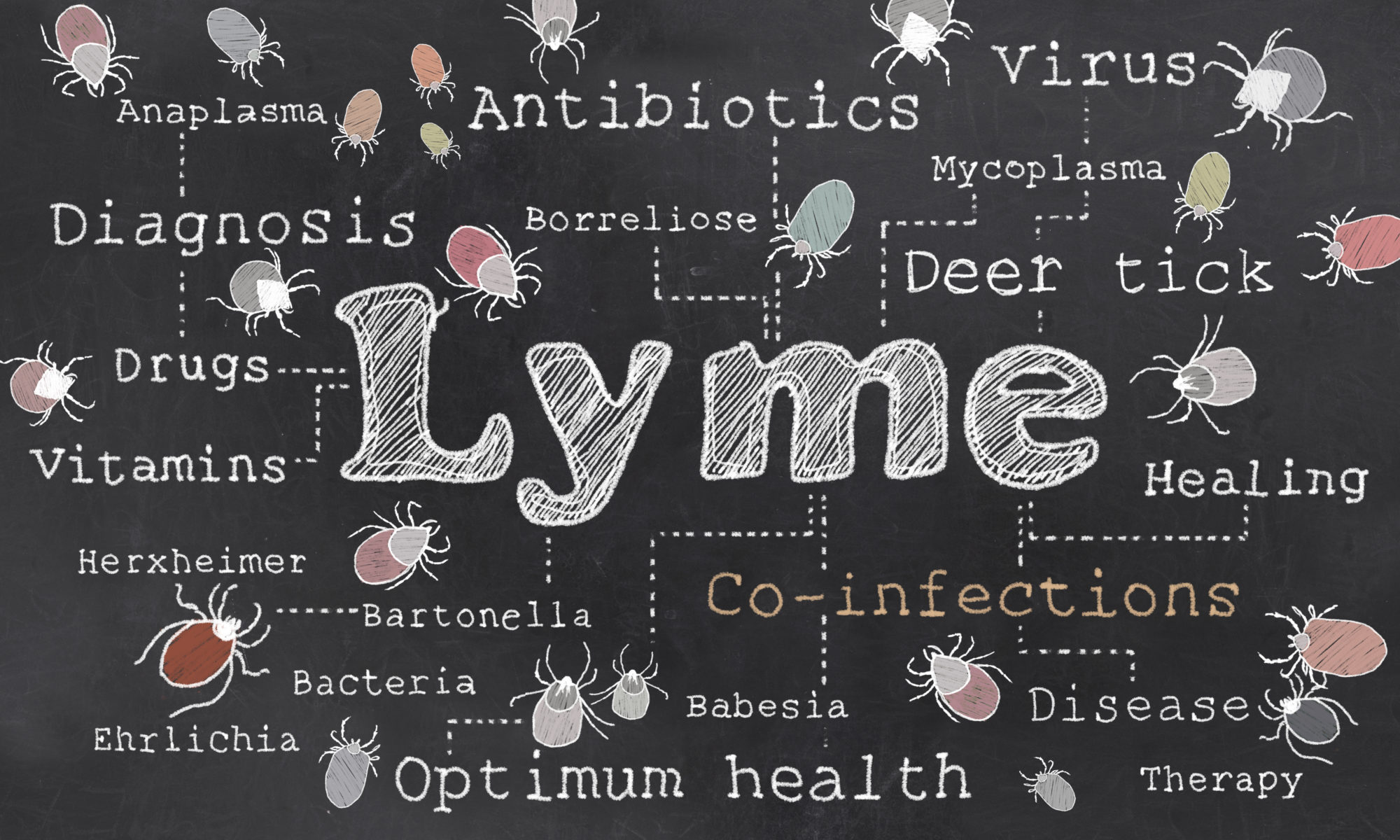 Lyme disease has become an epidemic, particularly in certain areas of the Country. It is found across North America, Europe, and Asia. About 10 – 15% of people diagnosed with Lyme disease go on to develop chronic Lyme disease, which can masquerade as several other chronic diseases, leading to misdiagnosis. If properly diagnosed, treated with a combination of antibiotics and quality nutritional supplements, many of the symptoms can be alleviated, and the individual has a good chance of getting his life back.
Lyme disease has become an epidemic, particularly in certain areas of the Country. It is found across North America, Europe, and Asia. About 10 – 15% of people diagnosed with Lyme disease go on to develop chronic Lyme disease, which can masquerade as several other chronic diseases, leading to misdiagnosis. If properly diagnosed, treated with a combination of antibiotics and quality nutritional supplements, many of the symptoms can be alleviated, and the individual has a good chance of getting his life back.
Nutritional supplements are safe and effective in reducing inflammation throughout the body, boosting the immune system without causing an over-reaction, and are needed to nourish, protect, and renew mitochondria, endogenous antioxidant enzymes, and all other cellular components. Healthy cells and a healthy immune system provide the best chances for good health.
Protocol for Lyme Disease
 I have created three protocol levels to be applied for the degree of severity of symptoms, and/or the desire of the individual to quickly reduce or eliminate the symptoms of Lyme disease. The supplements can be used in conjunction with antibiotics.
I have created three protocol levels to be applied for the degree of severity of symptoms, and/or the desire of the individual to quickly reduce or eliminate the symptoms of Lyme disease. The supplements can be used in conjunction with antibiotics.
Even if your Lyme disease symptoms are relatively mild, you may safely follow the optimal-dose protocol, which you may wish to consider, as the bacteria may lie dormant in your body for years. It is critical to keep your immune system at peak performance to help reduce the recurrent dissemination of the bacteria in your system, as well as repeat infections from future tick bites.
5-HTP, GABA, and L-Theanine are used in combination with the other supplements for neurological symptoms: depression, anxiety, and insomnia.
Ultra Lipoic Acid, Acetyl-L-Carnitine, and DHEA, are used in combination with the other supplements in the protocol.
The article and protocol are for informational purposes only, and not intended as medical advice. Please see medical disclaimer below, and consult with your personal physician prior to taking supplements and acting upon information in this article, protocol, or website.
Minimal Protocol for Lyme Disease

Basic Protocol for Lyme Disease
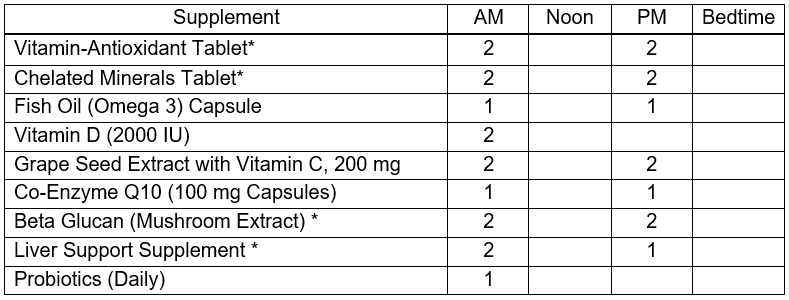
Average Protocol for Lyme Disease

Advanced Protocol for Lyme Disease

- AM: With, or after breakfast
- Noon: At lunchtime with food, or shortly thereafter
- PM: Late afternoon with food, or at, or after dinner
- *Please see my list of ingredients (below) that I like to see provided by a foundational vitamin and mineral supplement.
- Beta Glucan Polysaccharides, derived from Reishi and Shiitake Mushroom extracts, as well as Baker’s Yeast Extract.
- *Liver Support supplement that provides numerous ingredients, including N-Acetyl-L-Cysteine (NAC), turmeric extract (curcumin), green tea extract, olive extract, broccoli extract, alpha lipoic acid, milk thistle extract, and biotin.
- *Probiotics, at least take 12 billion colony-forming bacteria, providing Lactobacillus rhamnosus LGG® and Bifidobacterium BB12®, every other day or daily.
- 5-HTP, GABA, L-Theanine, DHEA (25 mg micronized capsule), Ultra Lipoic Acid, and Acetyl-L-Carnitine can all be purchased from Douglas Labs. You can buy from Douglas Labs by first creating a customer account by CLICKING HERE. (If this link does not work for you, simply type “douglaslabs.com/patient-account” into a new browser tab.) And, please use Referral Code 2074214.
Ingredients that I like to see provided collectively by vitamin-antioxidant & chelated mineral tablets
Vitamin A, mostly as Beta Carotene
Vitamin C
Vitamin D3
Vitamin E
Vitamin K (K1 & K2)
B-Complex Vitamins
Curcumin (turmeric extract)
Quercetin
Green Tea Extract
Olive Extract
Rutin
Resveratrol
Choline
Lutein
Lycopene
N-Acetyl-L-Cysteine (NAC)
Calcium
Magnesium
Iodine (as potassium iodide)
Zinc
Selenium
Copper
Manganese
Chromium
Molybdenum
Including Ultra Trace Minerals
Medical Disclaimer
Information on this website, written, spoken, or in any other communication by Dr. Ladd McNamara or any other information or reference is for informational purposes only. The information provided on this website is a result of years of practice, experience, and study by the author. This information is not intended as a substitute for the advice provided by someone’s personal licensed physician or other healthcare professional, or any information contained on or in any product label or packaging. Do not use the information on this website, or any other form of communication from Dr. Ladd McNamara or the Dr. Ladd VIP Program, for diagnosing or treatment of a health issue or disease, or for the prescribing of medication or the use of supplementation without a discussion with your licensed health professional first. At best, the information provided on this website is only meant to supplement information provided by your own doctor or health professional, not to replace medical advice. The information from this website is not meant to cover all possible uses, precautions, interactions or possible adverse effects of nutritional supplements with or without medications, or in conjunction with specific medical conditions. The information from this website may not fit your specific health circumstances. Never delay seeking medical care or disregard advice from your health care professional because of information you have received directly or indirectly from this website, from the Dr. Ladd VIP Program, or from Dr. Ladd McNamara himself. Always speak with your physician or other healthcare professional before making any changes to your medication or embarking on a nutritional, herbal or homeopathic supplement program, or before using any treatment for a health concern. If you have, or suspect that you have, a medical problem, contact your health care provider promptly. Do not disregard professional medical advice or delay in seeking professional advice because of something you have read or heard on this website, or due to any other information from Dr. Ladd McNamara or his representatives. Information provided on this website or the V.I.P. Program, and the use of any products or services mentioned on this website (or as a result of information provided this program, article, or website) by you DOES NOT create a doctor-patient relationship between you and Ladd McNamara, M.D. Information and statements regarding dietary supplements have not been evaluated by the Food and Drug Administration and are not intended to diagnose, treat, cure, or prevent any disease.
References
- https://www.cdc.gov/media/releases/2013/p0819-lyme-disease.html
- http://www.cdc.gov/cancer/breast/statistics/
- http://www.cdc.gov/hiv/statistics/basics/
- Johnson L, et al. Severity of chronic Lyme disease compared to other chronic conditions: a quality of life survey. Peer J. 2014;2:e322.
- Bratton RL, et al. Diagnosis and treatment of Lyme disease. Mayo Clin Proc. 2008 May;83(5):566-71.
- Seinost G, et al. Infection with multiple strains of Borrelia burgdorferi sensu stricto in patients with Lyme disease. Arch Dermatol. 1999 Nov;135(11):1329-33.
- Pritt BS, et al. Identification of a novel pathogenic Borrelia species causing Lyme borreliosis with unusually high spirochaetaemia: a descriptive study. Lancet Infect Dis. 2016 May;16(5):556-64.
- Hubálek Z, Halouzka J. Distribution of Borrelia burgdorferi sensu lato genomic groups in Europe, a review. Eur J Epidemiol. 1997 Dec;13(8):951-7.
- Berghoff W. Chronic Lyme Disease and Co-infections: Differential Diagnosis. Open Neurol J. 2012;6:158-78.
- yeh MT, et al. Determining the duration of Ixodes scapularis (Acari: Ixodidae) attachment to tick-bite victims. J Med Entomol. 1995 Nov;32(6):853-8.
- Keirans JE, et al. Ixodes (Ixodes) scapularis (Acari:Ixodidae): redescription of all active stages, distribution, hosts, geographical variation, and medical and veterinary importance. J Med Entomol. 1996 May;33(3):297-318.
- Peacock BN, et al. New insights into Lyme disease. Redox Biol. 2015 Aug;5:66-70.
- Strle K, et al. TH17 Cytokine Responses in Lyme Disease Correlate with Borreliaburgdorferi Antibodies During Early Infection in Patients with Erythema Migrans and with Autoantibodies Late in the Illness in Patients with Antibiotic-Refractory Lyme Arthritis. Clin Infect Dis. 2017 Jan 11. pii: cix002.
- Baig S, et al. Cells secreting antibodies to myelin basic protein in cerebrospinal fluid of patients with Lyme neuroborreliosis. Neurology. 1991 Apr;41(4):581-7.
- Arvikar SL, et al. Autoimmune Arthritides, Rheumatoid Arthritis, Psoriatic Arthritis, or Peripheral Spondyloarthritis Following Lyme Disease. Arthritis Rheumatol. 2017 Jan;69(1):194-202.
- Pancewicz SA, et al. [Vitamin A, E and C serum concentration in patients with Borrelia burgdorferi antibodies–non-symptomatic carriers.]. Przegl Epimemiol. 2005;59(1):35-41.
- Cantoma MT, Hayes CE. Vitamin A deficiency exacerbates murine Lyme arthritis. J Infect Dis. 1996 Oct;174(4):747-51.
- Russell TM, et al. The salt-sensitive structure and zinc inhibition of Borrelia burgdorferi protease BbHtrA. Mol Microbiol. 2016 Feb;99(3):586-96.
- Cristea V, Crisan M. Lyme disease with magnesium deficiency. Magnes Res. 2003 Dec;16(4):287-9
- Hawley KL, et al. CD14 targets complement receptor 3 to lipid rafts during phagocytosis of Borrelia burgdorferi. Int J Biol Sci. 2013 Aug 20;9(8):803-10.
- Lantos PM. Chronic Lyme disease. Infect Dis Clin North Am. 2015 Jun;29(2):325-40.
- Yang NJ, Chiu IM. Bacterial Signaling to the Nervous System through Toxins and Metabolites. J Mol Biol. 2017 Jan 6. pii: S0022-2836(17)30014-1.
- Sirisinha S. The potential impact of gut microbiota on your health:Current status and future challenges. Asian Pac J Allergy Immunol. 2016 Dec;34(4):249-264.
- Nadelman, RB, et al. Differentiation of reinfection from relapse in recurrent Lyme disease. N Engl J Med. 2012 Nov 15;367(20):1883-90.
- Koedel U, Pfister HW. Lyme neuroborreliosis. Curr Opin Infect Dis. 2017 Feb;30(1):101-107.
- Gasse T, et al. Neopterin production and tryptophan degradation in acute Lyme neuroborreliosis versus late Lymeencephalopathy. Eur J Clin Chem Clin Biochem. 1994 Sep;32(9):685-9.
- Hansen AM, Caspi RR. Glutamate joins the ranks of immunomodulators. Nat Med. 2010;16(8):856-858.
- Franco R, Pacheco R, Lluis C, et al. The emergence of neurotransmitters as immune modulators. Trends Immunol. 2007;28(9):400-407.
- Kim H, Seo JY, Roh KH, et al. Suppression of NF-kappaB activation and cytokine production by N-acetyl cysteine in pancreatic acinar cells. Free Radic Biol Med. 2000;29(7):674-683.
- Jiang XF, Zeng WY, Pu J, Liu YM. Effect of N-acetyl cysteine on lipopolysaccharide stimulating IL-8 expression of human uterine smooth cell. Sichuan Da Xue Xue Bao Yi Xue Ban. 2008;39(2):235-238.
- Geiler J, Michaelis M, Naczk P, et al. N-acetyl-L-cysteine (NAC) inhibits virus replication and expression of pro-inflammatory molecules in A549 cells infected with highly pathogenic H5N1 influenza A virus. Biochem Pharmacol. 2010;79(3):413-420.
- Dean O, Giorlando F, Berk M. N-acetylcysteine in psychiatry: current therapeutic evidence and potential mechanisms of action. J Psychiatry Neurosci. 2011;36(2):78-86.
All materials on this website, written, audio, visual, are copyrighted by Ladd McNamara, Inc., and are not to be distributed, duplicated, shared, posted to another website or social media sites (including Facebook, etc.), except for under the Terms of Use for sharing approved articles and videos.
As a VIP member, you agree that you will NOT share any written, audio, video, or any other proprietary materials from this website with those in your organization, other associates, or team members; and that you will only share approved articles/protocols and videos with your OWN PERSONAL & IMMEDIATE customers, clients, and prospective customers/clients. Doing so, would result in the loss of your Dr. Ladd VIP membership without a refund.
Thank you for your honesty and integrity.
About the Dr. Ladd VIP Program
There are many more articles on various subjects, as well as videos on health concerns, along with specific nutritional supplement protocols for managing health concerns and disease. Of course, this is all for informational purposes, and not to be taken as medical advice. (See medical disclaimer above.) Please learn more at www.drladdvip.com.
Please read about the benefits of being a Dr. Ladd VIP Member. It is a subscription-based personal program to better your health, energy, and passion for life, and for helping others. This program includes on-going support for yourself, and as you help customers and clients with your health enterprise.
Do you have a need to understand how NUTRITIONAL SUPPLEMENTS can benefit the health of people suffering from any number of chronic diseases; such as Heart Disease, Cancer, Diabetes, Arthritis, Dementia, Lyme Disease, Autoimmune Diseases, and Many More!
- Do you have a need for SUPPLEMENT PROTOCOLS as to what specific supplement combinations to use?
- How about WHY SUPPLEMENTS? How do you chose a QUALITY BRAND?
- Do you have a need to BETTER ASSIST CUSTOMERS in making a good decision?
- How about ON-GOING SUPPORT for ON-GOING QUESTIONS?
- How about YOUR PERSONAL HEALTH, and/or Your PERSONAL RELATIONSHIPS?
Happiness and Health includes not only being free of disease, but passionately engaged in a relationship, in life, and in helping others! It means living with less stress, more fun, and activity.
The Dr. Ladd VIP Program is about Vitality, Intimacy, and Passion, being balanced in all aspects of life, and helping others to get there too.
 Please read more at www.drladdvip.com, and take advantage of the Video Courses, the Supplement Protocols, Articles, Downloadable PDFs, and Dr. Ladd VIP Facebook Community and Support. “Have me in your back pocket” by becoming a VIP Member Today!
Please read more at www.drladdvip.com, and take advantage of the Video Courses, the Supplement Protocols, Articles, Downloadable PDFs, and Dr. Ladd VIP Facebook Community and Support. “Have me in your back pocket” by becoming a VIP Member Today!
If you are not a VIP member, please subscribe to my email list. If you are already a VIP member, no need to subscribe to the email newsletter list. Thank you.
dr. ladd
Please learn more about the Dr. Ladd VIP program here: www.drladdvip.com.
Please Subscribe to Dr. Ladd’s Email List
Receive health and website updates, as well as information on upcoming FREE health-related webinars.
All information, written or video, is copyrighted by Ladd McNamara, Inc., and is not to be shared, duplicated, or posted to other websites or social media platforms without express permissin from Ladd McNamara, M.D. Thank you.
Dr. Ladd’s V.I.P. Program and Website is Owned and Operated by Ladd R. McNamara, M.D. and Ladd McNamara, Inc., a California corporation.
